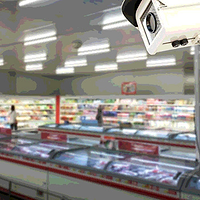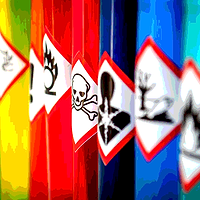April 24, 2016, an alert employee at a Whole Foods Market in Ann Arbor, MI, noticed a young man spritz liquid from a small spray bottle onto food in the hot food bar. The man, 29-year-old Kyle Bessemer, was arrested after the media published a surveillance image showing him carrying a red shopping basket and striding past the avocados. Bessemer told police he mixed a Tomcat rodent poison with water in a bottle of hand sanitizer, and over the past two weeks had sprayed the mixture on open salad and food bars at several local grocery stores. He was suspected of doing the same at 15 other foodservice establishments. Surveillance photos also showed Bessemer squirting liquid avocados as he squeezed them.
In his statement to police, Bessemer said he had a history of mental illness and thought people were poisoning him, and he ultimately was found unfit to stand trial. This time, nobody got sick from the watered-down poison, but the specter of “what if?” hovers over the affair. Imagine what could have happened if Bessemer had been what we call a “thinking adversary,” one who researched and carefully planned an operation targeting vulnerable, open salad bars. It’s happened before: Back in 1984, followers of Bhagwan Shree Rajneesh used Salmonella to poison more than 750 residents of The Dalles, OR. They deliberately contaminated salad bars at 10 local restaurants in hopes of incapacitating voters so their candidate would win in an upcoming county election.
And what if the culprit not only knew what he was doing but was an insider, someone who knew how to avoid security cameras and pick a time when no one would see him? What if he worked in the back, prepping salad bar ingredients? An insider could get into the system, find concentration points and make sure a poisoned product was widely distributed to the public.
This could have been a very different event. Fortunately, a Whole Foods employee was not only alert but willing to speak up; store management responded immediately, contacting local police and removing all produce and salad bar items; and officials at the local, state and federal levels responded rapidly, decisively and effectively. Now, there has been enough time to look back and ponder lessons learned. The number one thing to remember is that alert employees are the most important company asset in any food defense program. Food defense plans are important, but worthless without vigilant employees willing to act decisively. Food defense has to be a team effort.
The first thing that happened is that store management immediately contacted local police and removed produce and salad bar items to a landfill rather than using the food as animal feed or compost.
Lessons Learned:
• Quick removal of contaminated food material is essential to prevent spread of the incident.
• Removal of contaminated food material must be done in a way that does not allow the material to be a source of further contamination in animal feed or in the human food chain.
• At the time, limited samples were taken of the potentially contaminated food. Additional samples would have been desirable. Consultation with law enforcement officials before disposal of food material would also have been desirable.
• In the future, it would be wise to segregate food that is suspected to be contamined in a location where sampling by law enforcement can be accomplished, without danger of contaminating other, safe food or introducing the contaminated food into the human or animal feed chains.
The day after the incident, local law enforcement, the Federal Bureau of Investigation, HazMat, the county emergency operations center, the county public health department, the state health department and the Michigan Department of Agriculture and Rural Development (MDARD) mounted a coordinated, multiagency response. MDARD also notified the grocery industry.
Lessons Learned:
• The state system worked quickly and efficiently, but may have been somewhat delayed because the incident occurred on a Sunday. A thorough after-action review is expected to assess the response time.
• Incidents tend to occur at inconvenient times, including weekend and holidays. This should be considered the norm, and emergency plans should include contingencies for incidents when a minimal number of response personnel may be available. Further, after-hours emergency contact numbers for key personnel and key agencies is critical.
• Emergency response plans should include contingencies for segregating potentially contaminated food materials during off hours, as well as first-run sampling of contaminated materials. States, counties and municipalities should consider identifying collection points ahead of time, where suspect food materials could be collected and initial sampling initiated. These collection points need not be a stand-alone or sole use facility, but should be secure and a location where further contamination of the human or animal food supplies can be prevented.
• In the early stages, where identification of the contamination agent(s) has not occurred, it is essential that public access to the portion of the facilities and any equipment associated with the event be temporarily suspended, until which time the type of contamination be identified. Clean up in such instances should not be initiated until which time state or local HazMat does initial testing at the site, so as to ensure that radioactive materials or highly hazardous chemicals are not present.
The Michigan Public Health Laboratory screened the food suspected of contamination on April 27, 3 days after the incident, finding no evidence of select agents. The first multiagency call took place, and the store was notified that the risk to the public was low.
Lesson Learned:
Definitive identification of potential hazard(s) takes time beyond initial screenings by HazMat. There is no good go-around for this, and therefore food industry defense plans should take into consideration these types of inevitable lag times. Interruption of the process should be anticipated and contingencies built into the plan.
On April 28, four days after the incident, the Michigan Intelligence Operation Center generated an Official Use Only Bulletin and shared it with law enforcement and the grocery industry. The bulletin proved essential in the identification of the suspect by alerting other grocery store employees. An alert employee recognized the suspect and contacted law enforcement officials.
Lessons Learned:
• The decision to release information to the public in future events will be dependent on the nature of the hazard(s) and the state of the investigation. Rather than establishing a hard and fast rule, it is advisable that each case be handled independently with the watchword being transparency, wherever and whenever possible.
• Avoidance of panic by the public is an essential consideration in any decision.
• Release of information must also be done in such a way to avoid investigatory compromise.
The Big Picture
What can the government and the food industry gain from the “lessons learned?” Overall, the system worked well in Michigan, although there were also issues that both the private sector and the public sector agencies are working to address. There is always room in any plan for improvement. In fact, it is not certain that another municipality or state would have been as efficient. In all, 16 grocery stores were investigated by state officials, and the breadth of the investigation was costly. Not all jurisdictions would be able to quickly muster such resources, which could translate into the event spreading quickly and becoming even larger. Illness complaints first emerged after the public announcement. Although claims of illness ultimately proved to be unfounded or unrelated to the contamination events, the investigation nevertheless expended additional law enforcement and public health resources.
The motive to date still remains unknown, which is a troubling gap that may never be answered. There are indications mental illness may have been involved. Insight into the suspect’s motivations might give valuable clues into how the incidents evolved. Although the investigation to date has not uncovered information indicating involvement of others, that question remains open.
A particularly troubling aspect to any event like this is whether it could lead to copycat incidents. The event revealed vulnerabilities in grocery store food defense planning and operations. One of the conundrums in any incident investigation is the question of what should be exposed. Obviously, during the incident, the grocery stores that might be affected need timely information on what transpired and what to look for if similar events were to occur in their facilities. A thoroughly researched after-action report is also essential but may, in some cases, need to include redactions, particularly if proprietary information related to the affected facilities is exposed during the course of the investigation. Specific information related to the affected facility should be restricted to the owners of the facility, while more generalized lessons learned should be distributed industrywide as soon as possible.
The possibility of “thinking adversaries” must always be considered in planning for future events. A thinking adversary is one who will learn from personal mistakes or those of others. It is generally safe to say that future events will not be the same as those in the past. Frequently, in planning for future events, companies find security solutions for past events. Thinking adversaries know this and will plan work-arounds to overcome new strategies and safeguards implemented in response to the last incident. Planners need to anticipate generalities, rather than specific scenarios. A security camera system placed over a salad bar might be a valid response, but its placement could also cause a thinking adversary to shift attention to some other location in the grocery store. A whole-of-property camera system could be used to “prevent” this adversarial shifting, but can such a system actually prevent an event, or just detect an event once it has occurred? Security camera systems are very good to have, but are only as good as the comprehensive food defense program of which they are an essential part.
Threats evolve with the adversaries. Food defense plans must also evolve. What might have been effective in the past is not necessarily going to be effective in the future. Essential to any robust planning and operational execution is the training of personnel, who are going to be on the front lines when something occurs. They must be empowered with knowledge of what to look for in terms of suspicious activity and authority to act with the full support of the facility or corporation leadership. That being said, one threat that should not be minimized is the potential for events to be precipitated by insiders. Disgruntled employees are the most immediate problem for any corporation, food-based or otherwise. Insiders know the system and how it works, and they also know defense strategies and gaps. It is imperative to hire only thoroughly vetted individuals whose identities are definitively known, and for supervisory staff to monitor all employees’ activities and demeanor. Employees showing signs of discontent or agitation should be immediately removed from critical processes or functions, such as concentration points where large numbers of food products could be intentionally contaminated.
In terms of response improvements needed, Michigan identified first the need to take more and better samples should future events occur. When in question, always take more samples, thoroughly document their source and let the laboratories sort out what they do or do not need to test. Geocode everything and document sample location with imagery and video.
Another important conclusion in the lessons learned is the need for government agencies to better understand industry practices. This can only be accomplished if industry and government work cooperatively, which is never easy if collaboration is impeded by agencies that have both regulatory and emergency response authority. In times of emergency response, regulatory authorities must temporarily be subservient to the needs of the response. Sensitive, incomplete and rapidly changing information is very challenging to communication, but solutions to overcome these frictions must be found to prevent exacerbation of the emergency. In addition, emergencies are no time for meetings; conference calls with appropriate authorities and direct communications with liaisons should be used to communicate, not meetings. Briefings should be just that, brief and succinct, clearly communicating the knowns and unknowns. Goals for the response, as well as for the subsequent investigation, should be set as early as feasible. The most immediate goal is to identify the nature of the threat and contain its spread and therefore its impact. The investigation will come later. The investigation should never be allowed to impede the response.
Dr. R.A. Norton is chair of the Auburn University Food System Institute’s Food Defense Working Group and The Futures Laboratory, a collaboration between Auburn University, Auburn University-Montgomery and Air University at Maxwell Air Force Base. He can be reached at nortora@auburn.edu or 334.844.7562.
Brad Deacon is Michigan’s emergency management coordinator and director of the Office of Legal Affairs for the Michigan Department of Agriculture and Rural Development. He can be reached at 517.284.5729.




